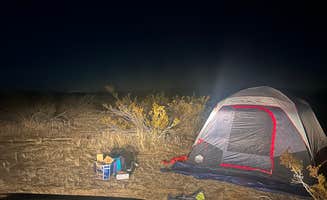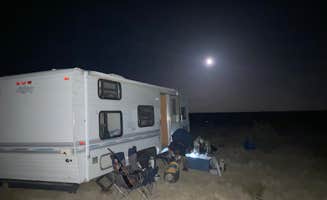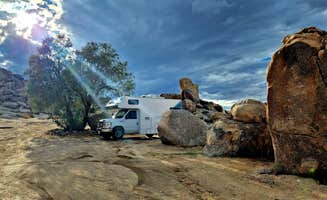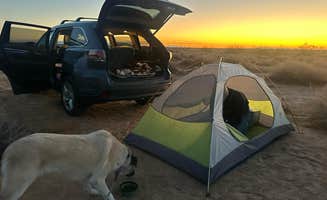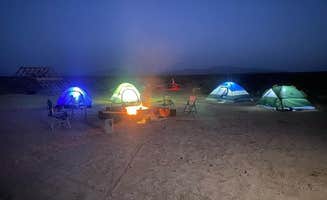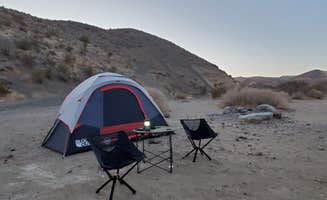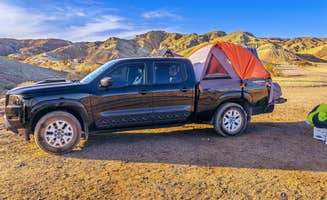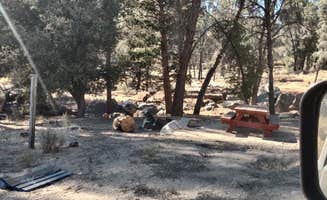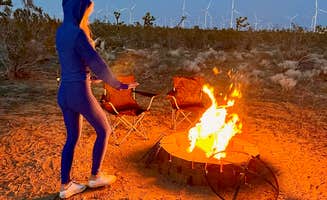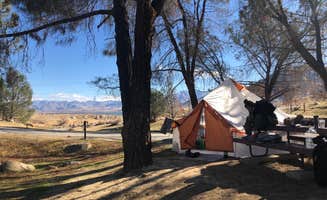Dispersed camping near Red Mountain, California extends across a rugged high desert landscape at elevations ranging from 2,500 to 4,000 feet. The region lies within the Western Mojave Desert, characterized by Joshua trees, creosote bush, and distinctive geological formations. Winter temperatures can drop to 20°F at night, requiring campers to prepare for significant daily temperature fluctuations of up to 40 degrees between day and night readings.
What to do
Explore rock formations: At Ricardo Campground in Red Rock Canyon State Park, the colorful cliffs provide natural shade and exploration opportunities. "The views from this campground are absolute stellar. The sites and pit toilets are clean and plenty of spaces were available" notes Michell C., who recommends selecting "sites up by the cliffs [which] offer the best views."
Photograph unique landscapes: Trona Pinnacles offers otherworldly scenery popular with photographers, especially during golden hour. "360 views no matter what spot you choose. Definitely plan on setting up camp before sunset so you can get a good spot to watch from all around," recommends Calli G., who suggests arriving with time to explore before the light changes.
Night photography: The desert darkness creates excellent stargazing conditions. At Wagon Wheel Staging Area, Michael A. found "a nice dark sky for star gazing," while at Ricardo Campground, Margaret P. reports "The Milky Way was out at night."
Off-road adventures: Multiple OHV areas cater to motorized recreation enthusiasts. The Dove Springs OHV Area provides "lots of land and trails" according to Jesus R., with therealquaid D. noting it offers "beautiful hikes nearby and private enough if you can keep away from the main road."
What campers like
Wide-open spaces: The dispersed camping areas provide ample room to spread out. Brandon C. appreciated Wagon Wheel Staging Area because "there were about 10 other groups there and still had plenty of space!" Similar sentiments are shared by campers at Trona Pinnacles, where Calli G. confirms "we drove in and found camping pretty easily on a Saturday evening."
Wildlife viewing: The desert ecosystem supports diverse wildlife. At Wagon Wheel, Stephanie F. spotted "chuckwalla lizards sun on top of the rocks" and reported "we also got a visit from a sidewinder rattlesnake," reminding campers to "wear boots, keep kids or animals close, respect the locals."
Accessible solitude: Despite proximity to highways, many sites offer quiet seclusion. At BLM Desert Site, Tyler D. discovered "a great little secluded spot about 4 miles off the highway in the desert," noting he "still had some service with Verizon" despite the remote location.
Dramatic sunrises: Early mornings showcase spectacular desert light. At BLM Desert Site, Erin V. experienced "great sunset and sunrise," while at Jawbone Canyon OHV Area, Jessie F. reported "the sunrise was beautiful!" despite the area being "very windy."
What you should know
Weather extremes: Wind poses the most significant challenge across all camping areas. At Dove Springs OHV Area, therealquaid D. warns it was "VERY windy, had to park my class C facing the wind to minimize swaying, but at times it felt like I was on a boat."
Road conditions: Access varies significantly between sites. Thomas R. notes at Wagon Wheel Staging Area there are "many spots—some only accessible by 4WD due to deep sand and dry waterways. There are plenty of 2WD spots, though." At Trona Pinnacles, one camper advises "If you have the option, air down your tires at the trailhead of the Trona Pinnacles dirt road. It makes the last 5 miles much more comfortable."
Variable cell service: Connectivity is spotty and carrier-dependent. At Monarch-Rand Mine, no reviewers mention cell service, while at Trona Pinnacles, Michelle W. reports "No AT&T service within a 10 mile radius."
Seasonal crowds: Holiday periods see significant increases in campers. Gary R. observes at Wagon Wheel Staging Area: "Most of the year you can be by yourself out here but at Thanksgiving be prepared to share."
Tips for camping with families
Site selection strategy: For families camping with young children, finding wind protection is essential. Sara S. advises at Wagon Wheel: "It's literally a big open desert flat and you park wherever so there's plenty of room for privacy" but cautions that "some sites are more trashed so watch for broken glass."
Educational opportunities: The geological features provide natural science lessons. At Ricardo Campground, Michelle W. observed "The desert was alive in April!" providing opportunities for seasonal wildlife and plant education, while the rock formations create natural exploration areas.
Safety precautions: The desert environment requires specific safety measures. At Wagon Wheel, Stephanie F. warns families should be "sure to wear boots, keep kids or animals close, respect the locals" after encountering wildlife including a rattlesnake.
Facilities planning: Most dispersed sites lack amenities, requiring advance preparation. The exception is Desert Empire Fair RV Park in Ridgecrest, where according to Brooke W., "Bathrooms were clean and well stocked. 3 stalls in the women's and the 3 showers for additional no charge. Each shower had 3 hooks and a seat."
Tips from RVers
Leveling challenges: Many sites require careful positioning for RVs. At Ricardo Campground, Leonard H. notes "Most sights have a little slope... used a few leveling blocks," and cautions that while sites near the cliffs offer the best views, "many may be difficult to get level in if you have a motorhome or travel trailer."
Hookup options: Most areas are dry camping only. For full hookups, Brooke W. recommends Desert Empire Fair RV Park as "a perfect stop to dump, fill water, do laundry and just do an overall reset of our RV" with reasonable rates: "$35 for pull through site for capacity up to 42'."
Road navigation: RV-specific road concerns affect site accessibility. For Cuddeback Road Dispersed Camping, Jordan H. with a "21' travel trailer" reports "Easy access. Wide open spaces" while at Dove Springs OHV Area, therealquaid D. notes "the main dirt road is wide and flat so it's pretty easy to drive on. I saw a couple of Class As and families camp here."
Off-season advantages: RVers can find more comfortable conditions outside summer months. Brett L. suggests visiting Borax Bill Substation "toward the end of the year when it is not so hot (Oct-Dec)" though he cautions they "have had a variety of weather over the years. From beautiful skies, to wind, rain and snow."


